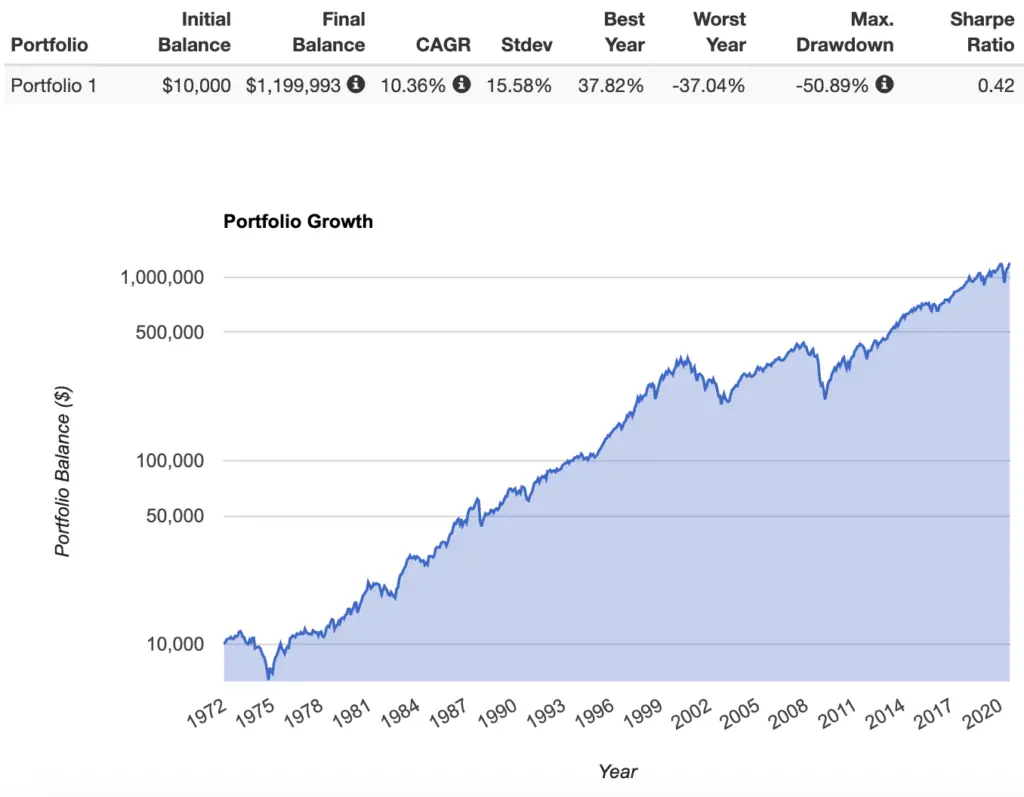The JL Collins Simple Path to Wealth Portfolio is one of the simplest lazy portfolios around. Here we’ll take a look at its components, performance, and the best ETFs to use in its implementation.
Interested in more Lazy Portfolios? See the full list here.
Disclosure: Some of the links on this page are referral links. At no additional cost to you, if you choose to make a purchase or sign up for a service after clicking through those links, I may receive a small commission. This allows me to continue producing high-quality content on this site and pays for the occasional cup of coffee. I have first-hand experience with every product or service I recommend, and I recommend them because I genuinely believe they are useful, not because of the commission I may get. Read more here.
Contents
Video
Prefer video? Watch it here:
Who Is JL Collins?
JL Collins has held many jobs and has traveled the world, and is now a book author and a financial blogger. His bestselling, self-published financial book The Simple Path to Wealth can be found on Amazon here.
Collins's book is very approachable for beginners interested in investing and personal finance, especially those with a DIY mindset. That's very much the audience for which it is written. From a technical standpoint, it is indeed “simple” and imprecise.
Collins is very much a Boglehead – a follower of Jack Bogle, the father of index investing and founder of Vanguard. Collins lays out his personal experience and success with low-cost index investing with a long-term approach instead of focusing on short-term shiny objects. Like Bogle (and me), he staunchly opposes things like day trading, active management, market timing, etc. that can seduce novice investors for far too long.
JL Collins advocates for frugality, planning, diversification, and low-fee investing as “a simple path to wealth.” Can't argue with that. Long-term approaches and lazy portfolios like these are admittedly boring, but that doesn't have to be a bad thing. Bogle espoused the “majesty of simplicity.”
What Is the Simple Path To Wealth Portfolio?
The Simple Path to Wealth Portfolio is precisely that. Collins suggests one needs only one index fund – the total U.S. stock market – for that path, allowing you to be fully diversified across all sectors and cap sizes. I'm not really sure how/why one can attribute a self-named portfolio to a single broad index fund that is just the total stock market of a country, but here we are. The JL Collins Simple Path to Wealth Portfolio is as follows:
100% U.S. Stock Market
JL Collins Simple Path To Wealth Portfolio Performance
Since the JL Collins Simple Path to Wealth Portfolio is just the entire U.S. stock market and nothing else, we can see performance data from 1972 through 2019:

During that time, we can see the U.S. stock market has had a CAGR above 10%, but with pretty significant volatility and drawdowns as we'd expect. And there's the rub. With its extreme simplicity, although the Simple Path to Wealth portfolio is diversified across all sectors and cap sizes, we're still investing in only one asset type in one single country.
Criticisms of the JL Collins Simple Path To Wealth Portfolio
Consequently, I firmly disagree with JL Collins on two main points, which are the two primary criticisms of the Simple Path to Wealth Portfolio:
No International Stocks
JL Collins argues that dedicated exposure to ex-US stocks is unnecessary because U.S. companies do business overseas. I've always found this argument pretty silly. I think it is a flawed, lazy, reductive view of global equities investing.
First, a U.S. company will act like a U.S. stock regardless of where its sales are coming from. That is, a single stock's market risk component will move with the broader U.S. stock market.
Secondly, the U.S. is one single country out of many in the world; we wouldn't expect it to outperform every year, and indeed it hasn't historically. If it did, that outperformance would also lead to relative overvaluation and a subsequent reversal. Meb Faber found that the U.S. stock market has outperformed foreign stocks by 1% on average historically, but all that outperformance has come after 2009! For example, during the period 1970 to 2008, an equity portfolio of 80% U.S. stocks and 20% international stocks had higher general and risk-adjusted returns than a 100% U.S. stock portfolio.
Look at Japan to know why we shouldn't solely invest in a single country. South African stocks have beaten the U.S. historically. It should also be obvious that we shouldn't go all in on those either.
In short, geographic diversification in equities has huge potential upside and little downside for investors.
I went into the merits of international diversification in even more detail in a separate post here if you're interested.
No Asset Class Diversification
JL Collins claims that he “hates bonds.” Again, this statement seems reductive, simplistic, and downright erroneous. While I'm the first to support young investors holding 100% stocks for a while to maximize growth, Collins's blanket argument against bonds is completely unfounded. He claims that since we should ignore the short term noise of any market turmoil during accumulation, we don't need bonds. That sounds great on paper, but the emotional and psychological aspects of investing are unfortunately very real. The reality is most investors will pay attention to the short term noise and don't have the stomach for a 100% stocks position during a market crash.
Investors tend to severely overestimate their tolerance for risk, only realizing it during a crash when they panic sell. Asset allocation should obviously depend on one's time horizon and personal risk tolerance; one that lets you sleep at night and stay the course is the right one for you, which may very well include bonds. And since we're talking about a lazy portfolio in which allocations may not change over one's investing horizon, it would be naive to simply throw bonds out the window for no reason, and any advisor worth their salt would and should scoff at the idea.
Collins does admit that an investor at or nearing retirement should probably have some bonds in their portfolio, but even then he caps it at 25% and makes no mention of TIPS. That doesn't make much sense either. I suppose he's never heard of sequence risk or inflation.
But long bonds also beat stocks from 2000 to 2020 with much lower volatility and risk, so a “lower performance” argument doesn't hold much weight either. If we look at STRIPS (e.g. $EDV), the performance difference widens even further. We also know there have been plenty of periods where the market risk factor premium was negative, i.e. T Bills beat the stock market – the 15 years from 1929 to 1943, the 17 years from 1966-82, and the 13 years from 2000-12. I've ranted about bonds elsewhere here.
Collins claims to be a Boglehead, but he must have missed the sections on international stocks and global bonds…
JL Collins Simple Path To Wealth Portfolio ETF Pie for M1 Finance
M1 Finance is a great choice of broker to implement the JL Collins Simple Path to Wealth Portfolio because it has zero transaction fees and allows for fractional shares. I wrote a comprehensive review of M1 Finance here.
Using Vanguard's low-cost ETF for the total U.S. stock market, we can construct the JL Collins Simple Path to Wealth Portfolio pie like this:
VTI – 100%
You can add the JL Collins Simple Path to Wealth Portfolio pie to your portfolio on M1 Finance by clicking this link and then clicking “Invest in this pie.”
Adding Some Bonds
Older investors or those with a lower risk tolerance will probably prefer to hold some bonds. I'm a fan of an 80/20 asset allocation for the “average” investor. Using Vanguard's Total U.S. Bond Market ETF, we can construct an 80/20 Simple Path to Wealth Portfolio as follows:
VTI – 80%
BND – 20%
You can add this pie to your M1 Finance portfolio by clicking here.
Want to add some international stocks? It then becomes the Bogleheads 3-Fund Portfolio.
Conclusion
The general Boglehead philosophy of index investing put forth by JL Collins is great. His specific investing advice is perhaps not so great. My criticisms above may sound harsh, but I find it strange that someone would draw hard, subjective conclusions and publish a book without taking a few minutes to look at some data.
Granted, again, it's meant to be “simple” and his beginner audience would not be expected to challenge him on his positions. So in short, diversify globally and add bonds (asset allocation) based on your personal time horizon and risk tolerance. In other words, consider the Bogleheads 3 Fund Portfolio.
What do you think of the JL Collins Simple Path To Wealth Portfolio? Let me know in the comments.
Are you nearing or in retirement? Use my link here to get a free holistic financial plan and to take advantage of 25% exclusive savings on financial planning and wealth management services from fiduciary advisors at Retirable to manage your savings, spend smarter, and navigate key decisions.
Disclosure: I am long EDV in my own portfolio.
Interested in more Lazy Portfolios? See the full list here.
Disclaimer: While I love diving into investing-related data and playing around with backtests, this is not financial advice, investing advice, or tax advice. The information on this website is for informational, educational, and entertainment purposes only. Investment products discussed (ETFs, mutual funds, etc.) are for illustrative purposes only. It is not a research report. It is not a recommendation to buy, sell, or otherwise transact in any of the products mentioned. I always attempt to ensure the accuracy of information presented but that accuracy cannot be guaranteed. Do your own due diligence. I mention M1 Finance a lot around here. M1 does not provide investment advice, and this is not an offer or solicitation of an offer, or advice to buy or sell any security, and you are encouraged to consult your personal investment, legal, and tax advisors. Hypothetical examples used, such as historical backtests, do not reflect any specific investments, are for illustrative purposes only, and should not be considered an offer to buy or sell any products. All investing involves risk, including the risk of losing the money you invest. Past performance does not guarantee future results. Opinions are my own and do not represent those of other parties mentioned. Read my lengthier disclaimer here.

Are you nearing or in retirement? Use my link here to get a free holistic financial plan and to take advantage of 25% exclusive savings on financial planning and wealth management services from fiduciary advisors at Retirable to manage your savings, spend smarter, and navigate key decisions.



In what time period did international outperform US stock ? What index are you using to compare US stock to international to prove this ?
I find it very hard to invest in international stocks when I look back to 1996 until now and see how much the US stock have outperformed international.
Thanks
Richard
See this post.
I can’t recall if this Richard was me or another Richard. I can’t tell because my views on international have changed over the past couple years, and your articles played a strong role in that adjustment.
Thank you for the wonderful articles on your site.
Thanks!